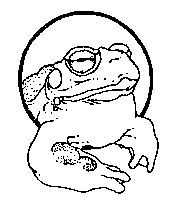 The Sonoran Desert Toad
The Sonoran Desert Toad The Sonoran Desert Toad
The Sonoran Desert Toad
Bufo alvarius
Toad Poisoning
Toads are Back!
By Oscar
Salutations to all you pet owners out there! My friends here at Animal Care and Control send their greetings and hope the heat isn't getting you down.
It's that time again where we are getting calls about toads and their effect on dogs. Our readers are talking about the Colorado River toad (Bufo alvarius) that climbs out of the mud during our Arizona monsoon season. You can hear these toads croaking everywhere after a good rain. They love to congregate under porch lights to catch bugs and scare the heck out of unsuspecting humans who just about step on them.
The main problem with these toads is they can cause toad poisoning when your pet tries to play with them. And most of my canine friends simply can't leave them along. Toads are strange looking and we just have to investigate. The most common way for us to do that is to smell or lick and that's when the trouble starts.
Toads have skin glands that secrete toxins. Worse yet - these toxins do not have to be swallowed for their effects to begin. They are very easily absorbed through the pet's mouth linings. Dogs typically shows signs of mouth irritation, excessive drooling and abnormal breathing. Affected animals may also develop heart arrhythmias, seizures, weakness and collapse. Sever toxicities can quickly lead to death if not treated.
So what do you do if you see your pet playing with a toad or suspect toad poisoning? The first and most important step is to wash the pet's mouth thoroughly with water. This will prevent further absorption of the toxin. Then call your veterinarian. Cats usually don't develop toad poisoning. Our local veterinarians tell me that most cases like this are seen in dogs. Lady Di tells me that "no self-respecting cat would toy with those ugly creatures anyway." Cats just don't know how to have a good time!
From: http://co.pinal.az.us/AnimalControl/column/archive/pdf/1999/21Jul99.pdf

Bufo Toads: Some 16 species of Bufo toads are found around the world. Bufo alvarius (Colorado River toad) is found in the Southwest, and Bufo marinus is found in Florida and Hawaii. Bufo's are attracted to dogs' watering dishes, and may sit in the rim long enough to leave enough toxin to make a dog ill. Untreated death rate, especially for Bufo marinus may approach 100%. Dogs may mouth bufo toads, thus getting a large dose of the bufo's toxins, secreted from the skin and paratid glands. Symptoms generally include profuse foamy salivation that looks like shaving cream, difficulty breathing, convulsions, paralysis, ventricular fibrillation, vomiting, cyanosis, and hallucination. Author Cargill had experience with an adult Doberman bitch, Kiku, and a Bufo marinus several years ago while in Hawaii. She salivated profusely, had labored breathing, an irregular heart beat, and the wildest-looking eyes ever seen in a Doberman. It took her the better part of a day and a night to recover untreated. Treatment involves dealing with three poisoning mechanisms: cardiac glycoside effects, pressor (tending to increase blood pressure) effects and hallucinogenic effects. Emesis (vomiting) may be indicated if there was a recent substantial ingestion and the dog is sufficiently alert. Repeated oral charcoal doses (every 2-6 hours) may help reduce the duration of poisoning. A saline cathartic or Sorbitolâ may be given with the first charcoal dose. Intravenous insulin, glucose, and sodium bicarbonate may be required to combat life-threatening hyperalalkemia (elevated serum pH levels). Atropine, phenytoin and lidocane may be useful in the management of bradycardia (abnormally slow pulse) and other cardiac irregularities. Cholestryamine may enhance elimination of bufagin (one of the several bufo venon toxins). Bufo toads are not all that uncommon in some parts of the nation, but very serious business, indeed. From: http://www.malteseadoption.com/bufo_toad.htm
See also: TOAD TOXINS